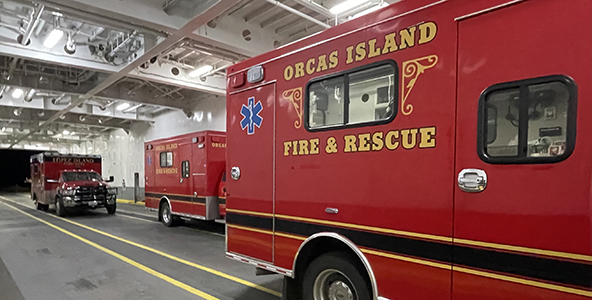(Reprinted upon request from November 1, 2013)
– by Lin McNulty –
UPDATED: November 1, 1 p.m.
Since the October 14 Orcas Issues piece on medical evacuation services available on Orcas, things have changed a wee bit. Airlift Northwest (ALNW) has pulled out of the Association of Air Medical Membership Program (AAMP). They are currently in negotiations with individual members of the Association, but are not, nor do they anticipate, being in discussions with Island Air Ambulance for a reciprocal agreement.
According to Chris Martin, Executive Director of Airlift Northwest, they see Island Air Ambulance as being a different program and providing a different service, even though Island Air Ambulance is currently a certified member of AAMP. Other agencies of AAMP “are more of a mirror image of what ALNW offers,” says Martin.
Airlift Northwest
ALNW is affiliated with University of Washington Medical and has been providing air evacuation services throughout Washington and Alaska since 1982. The ALNW fleet consists of four helicopters, one Lear jet, and one Turbo-Commander prop helicopter, based in Arlington, Bellingham, Olympia, or Seattle.
ALNW membership is available for $79/year per household. Although other medical insurance is required for membership, Martin emphasis that “we fly first, and bill later.” Whether someone has a membership is not considered at the time of emergency. Last year, ALNW provided $7.2m in charity care. Private insurance, however, will be billed for services provided.
ALNW is accredited by the Commission on Accreditation of Air Medical Transport Systems (CAMT), and is certified, through the State Department of Health, as an ALS (Advanced Life Support) carrier, as well as being designated as a trauma provider.
ALNW currently has 4,800 members residing in the San Juans, which is nearly half of their total membership. 1,181 of those members are from Orcas Island.
Island Air Ambulance
Island Air Ambulance is based in Friday Harbor, operated through the San Juan Island EMS district ,and affiliated with PeaceIsland Medical Center. Emergency medical services on San Juan are not operated through the Fire District as they are on Orcas.
Island Air Ambulance is also accredited by the Commission on Accreditation of Air Medical Transport (CAMT), and certified through the State Department of Health as an ALS (Advanced Life Support) carrier.
The medically configured, FAA approved, and CAMTS accredited fixed-wing aircraft of Island Air Ambulance transport patients requiring rapid evacuation to the mainland, and are outfitted with all of the necessary equipment and patient carrying devices needed to provide patient care in the air.
San Juan County EMS Chief Jim Cole expresses his regret that ALNW has decided to no longer be a member of AAMP. “We are concerned,” he continues, “that there is now a need for islanders to have two memberships when we worked so hard to get it down to one. We are still here to serve the needs of San Juan County. We hope ALNW will reconsider its decision.”
Membership in Island Air Ambulance is $55/year per household and there is no requirement for other insurance, although private insurance you have will be billed on your behalf for services provided.
Orcas Fire and Rescue Policy
Chief Kevin O’Brien and Assistant Chief both indicate that OIFR has clear protocols and considerations for transport of a patient needing to go to a mainland hospital.
- Safety: This includes the ability of an aircraft to land based in such variables as weather (both here and the weather where the aircraft is based). There are times when a fixed-wing plane is able to land when a helicopter is not, or a helicopter is able to land where a fixed-wing is not.
- Best Course of Action for Patient: What level of care is required for the patient to be transported? Both ALNW and Island Air Ambulance are certified as ALS carriers, but only ALNW is certified for trauma patients. This has to do with the equipment on board the aircraft, rather than the personnel on board. “The first priority is not based on membership,” states Assistant Chief Preysz, “but rather on patient care.”
- ALNW always flies with two Nurses. Island Air Ambulance crew may be configured as (1) a Paramedic and EMT, (2) a Nurse and a Paramedic, or (3) a Nurse and an EMT.
- Mode Availability of Carrier: Which carrier has which equipment available at any given time? An effort is also made to not request a higher level of transport than is necessary so as to maintain the fleet as highly equipped as possible.
- Membership: Only after other priority considerations is the air care membership and/or preference of the patient taken into consideration.
Although ALNW flies directly to a hospital, and Island Air Ambulance flies to a nearby airport, notes Chief O’Brien, “either way there will be an additional ambulance fee for transport from the landing site to the emergency room.”
Bottom Line
Chief O’Brien explicitly expresses the high level of satisfaction with both Island Air Ambulance and Airlift Northwest. “They both provide a vital service,” he says. “Our departments and our leaders are committed to work as partners” to continue to provide the high level of emergency medical treatment we have come to expect on Orcas.
In addition to ALNW and Island Air Ambulance, OIFR also has agreements with the Navy and the Coast Guard for air or vessel transport when necessary.
And, Chief O’Brien notes, “the O’Brien family has a membership with both Airlift Northwest and with Island Air Ambulance.”
**If you are reading theOrcasonian for free, thank your fellow islanders. If you would like to support theOrcasonian CLICK HERE to set your modestly-priced, voluntary subscription. Otherwise, no worries; we’re happy to share with you.**








Without prejudice to either provider, this situation begs the question, why cannot the representatives of the two providers speak with one another and work out a reasonable compromise that does not require islanders to purchase two annual memberships? Is an adult needed in the sandbox? Come on kids.
The oft asked question we get as a B&B owner is “how can we get off the island in case the need for emergency medical services arises during our stay” Our answer, at least up till now has been, “The emergency medical care response and transportation to trauma centers is as good or better than is available on the mainland”. I wonder, in light of the changes outlined here in what is available for emergency care, if that is still an accurate statement?
Regarding the issue of two providers of similar services, I don’t mind shopping for the insurance I wish to purchase. We find both to be valuable at a combined cost of $134/year. Regarding the quality of EMS, we find two med-flight service providers better than one!